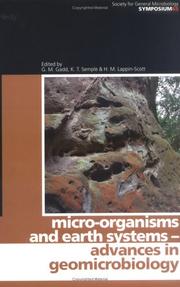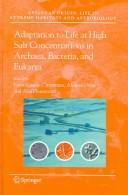| Listing 1 - 3 of 3 |
Sort by
|
Book
ISBN: 1501509551 Year: 2005 Publisher: Chantilly, Virginia : The Mineralogical Society of America,
Abstract | Keywords | Export | Availability | Bookmark
 Loading...
Loading...Choose an application
- Reference Manager
- EndNote
- RefWorks (Direct export to RefWorks)
Volume 59 of Reviews in Mineralogy and Geochemistry ties together themes common to environmental microbiology, earth science, and astrobiology. The resesarch presented here, the associated short course, and the volume production were supported by funding from many sources, notably the Mineralogical Society of America, the Geochemical Society, the US Department of Energy Chemical Sciences Program and the NASA Astrobiology Institute.
Geomicrobiology --- Microbial ecology --- Manganese --- Environmental aspects

ISBN: 9780511754852 9780521862226 0511141300 9780511141300 051114122X 9780511141225 0521862221 1107156599 1280955708 9786610955701 1139131850 0511351216 0511140983 051175485X 9781107156593 9781280955709 6610955700 9781139131858 9780511351211 9780511140983 Year: 2005 Publisher: Cambridge : Cambridge University Press,
Abstract | Keywords | Export | Availability | Bookmark
 Loading...
Loading...Choose an application
- Reference Manager
- EndNote
- RefWorks (Direct export to RefWorks)
There is growing awareness that important environmental transformations are catalysed, mediated and influenced by microorganisms, and geomicrobiology can be defined as the influence of microorganisms on geologic processes. This is probably the most rapidly growing area of microbiology at present, combining environmental and molecular microbiology together with significant areas of mineralogy, geochemistry and hydrology. This volume focuses on the function of microorganisms in the environment and their influence on 'global' processes. It will include state-of-the art approaches to visualisation, culture and identification, community interactions and gene transfer, and diversity studies in relation to key processes. This overview for researchers and graduate students will represent environmental microbiology in its broadest sense and help to promote exciting collaborations between microbiologists and those in complementary physical and chemical disciplines.
Geomicrobiology --- Microorganisms --- Germs --- Micro-organisms --- Microbes --- Microscopic organisms --- Organisms --- Microbiology --- Geological microbiology --- Microbiological geology --- Geobiology --- General microbiology --- Earth systems

ISBN: 1280412542 9786610412549 1402036337 1402036329 9048169143 Year: 2005 Publisher: Dordrecht : Springer,
Abstract | Keywords | Export | Availability | Bookmark
 Loading...
Loading...Choose an application
- Reference Manager
- EndNote
- RefWorks (Direct export to RefWorks)
Salt is an essential requirement of life. Already from ancient times (e. g. , see the books of the Bible) its importance in human life has been known. For example, salt symbolizes destruction (as in Sodom and Gomorra), but on the other hand it has been an ingredient of every sacrifice during the Holy Temple periods. Microbial life in concentrated salt solutions has fascinated scientists since its discovery. Recently there have been several international meetings and books devoted entirely to halophiles. This book includes the proceedings of the “Halophiles 2004” conference held in Ljubljana, Slovenia, in September 2004 (www. u- lj. si/~bfbhaloph/index. html). This meeting was attended by 120 participants from 25 countries. The editors have selected presentations given at the meeting for this volume, and have also invited a number of contributions from experts who had not been present in Ljubljana. This book complements “Halophilic Microorganisms”, edited by A. Ventosa and published by Springer-Verlag (2004), “Halophilic Microorganism and their Environments” by A. Oren (2002), published by Kluwer Academic Publishers as volume 5 of “Cellular Origins, Life in Extreme Habitats and Astrobiology” (COLE), and “Microbiology and Biogeochemistry of Hypersaline Environments” edited by A. Oren, and published by CRC Press, Boca Raton (1999). Salt-loving (halophilic) microorganisms grow in salt solutions above seawater salinity (~3. 5% salt) up to saturation ranges (i. e. , around 35% salt). High concentrations of salt occur in natural environments (e. g.
Archaebacteria --- Bacteria --- Eukaryotic cells --- Extreme environments --- Effect of salt on. --- Microbiology. --- Extremophiles (Microbiology) --- Geomicrobiology --- Microbial ecology --- Extremozymes --- Eucaryotic cells --- Cells --- Protista --- Germs --- Microbes --- Prokaryotes --- Archaea --- Archaeobacteria --- Biochemistry. --- Biochemistry, general. --- Biological chemistry --- Chemical composition of organisms --- Organisms --- Physiological chemistry --- Biology --- Chemistry --- Medical sciences --- Microbial biology --- Microorganisms --- Composition
| Listing 1 - 3 of 3 |
Sort by
|

 Search
Search Feedback
Feedback About UniCat
About UniCat  Help
Help News
News